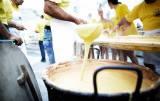Comune di Urbino
Via Puccinotti, 3 – 0722 3091
www.comune.urbino.ps.it
info@comune.urbino.ps.it
Located at 485 m of alt . in the sub-Apennine internal , between the valleys of the Leaf and the Metaurus . Located on two hills and is mostly surrounded by walls and ramparts.
Home to Free University founded in 1506 , Academy of Fine Arts and Institute for decoration and book illustration . The city, for its historical , artistic and cultural Pesaro is associated with the name of the province.
Birthplace of Raphael , Baroccio and Brandani . Poor are the remains of Romanesque , Gothic and age belong the churches of San Domenico (front from 1365 ) , with a Renaissance portal and the interior redone by Luigi Vanvitelli ( 1727-1732 ) , and that of St. Francis, the second half of the fourteenth century. , also transformed the interior by Vanvitelli (1740 ) . Gothic style is also the oratory of St. John the Baptist , where there are frescoes ( 1416 ) by the Salimbeni brothers .
THE DUCAL PALACE
The greatest monument of Urbino , was begun shortly after 1450, on the initiative of Duke Federico da Montefeltro , on the ruins of the ancient fortress and its realization RTEmagicC_Palazzo_20Ducale.jpgparteciparono to an extent completely definable , Luciano Laurana ( 1468-1472 ) and Francesco di Giorgio Martini and , much later (1563) , Girolamo Genga , who added a floor to the building. The interior of the building retains only part of the works carried out by the many artists who worked for the Duke Federico: remains the Communion of the Apostles of Justus of Ghent and some of the portraits of illustrious men who performed the Flemish painter , Pedro Berruguete , for Duke ‘s study that still retains the famous inlaid decoration , probably executed by B. Pontelli on drawings by Botticelli and Francesco di Giorgio Martini .
Symbol of the Italian Renaissance and birthplace of Bramante and Raphael, with its original urban structure and most of the buildings of its golden age .
Every year in August with Urbino celebrates the Feast of the Duke : a re-enactment in costume through the streets of downtown involving acrobats and fire eaters , culminating in the battle between counties in the presence of the Ducal Court .
DO NOT MISS
Museo – Albani Diocesan maintains a collection of ceramics, religious artifacts and the painting of the Last Supper by Federico Barocci (XVI century )
Church of St. Dominic by the magnificent travertine portal on which set bezel is a work of Luca della Robbia ;
St. Joseph’s Oratory , famous for the stucco crib in 1522. Guidantonio In 1416 the Count summoned the brothers Lorenzo and Jacopo Salimbeni sanseverinati to fresco the chapel , followed by Ottaviano Nelli and the Ferrara Antonio Alberti ;
Oratory of St. John the Baptist (XIV century ) whose interior is decorated with frescoes of the fifteenth century , including the crucifixion of the fifteenth century. and the life of the saint , the work of Lorenzo and Jacopo Salimbeni ;
The Cathedral , which stands between the intricate medieval alleys , made by Laurana , and rebuilt by Valadier in 1784 after an earthquake and was rebuilt in the following century Palladian RTEmagicC_duomo_urb_01.jpgforme . It contains works by Timoteo Viti and Federico Barocci ;
Church of St. Francis, c. XIV , with its beautiful Gothic tower with spire and the great altarpiece of Federico Barocci. It was rebuilt by Vanvitelli (first half of 700) , is home to the tombs of the dukes (there are sarcophagi of Antonio and Oddantonio ) ;
Church of San Bernardino Zoccolanti , (built by Francesco di Giorgio Martini ) is home to the Museum of the Dukes , out of town (you will be buried with his wife Elizabeth and his son Guidobaldo ) . Housed until the last century “Madonna and Child with Angels and Saints ” and the ” Duke Federico on your knees” by Piero della Francesca ( now in the Pinacoteca di Brera in Milan);
Raphael’s house home to the Academy , founded in 1869 ;
The Albornoz Fortress , the fifteenth century. , Located in Viale B. Buozzi and is the emblem of the city’s defense of the sixteenth century .
NATIONAL GALLERY OF BRANDS
RTEmagicC_piero_della_fr.jpgOspitata in the Ducal Palace , contains masterpieces such as the ” Flagellation ” and the “Madonna of Senigallia ” by Piero della Francesca , the ” Muta ” by Raphael Sanzi , and other major artists: Domenico Rosselli, Allegretto Nunzi , John Baronzio , Peter da Rimini, Antonio da Fabriano, Giovanni Santi , Melozzo from Forlì, Carlo Crivelli , Alvise Vivarini , Titian, Taddeo Zuccari . Some works , dispersed in 1623 , have returned to Urbino allowing the construction of the tunnel .
And again, down to the valley , the beautiful urban landscape that is enjoyed by Borgo Mercatale with the looming semi-cylindrical volume that encloses the fifteenth-century spiral ramp to Francesco di Giorgio Martini .




 The village of San Costanzo is a village rich in history and tradition also documented also by the century-old Polentara Festival, the oldest festival of the Marches, which takes place both in March than in July and where you can enjoy delicious polenta with numerous varieties of sauces prepared according to a recipe handed down over the years and jealously guarded. The Festival represents an appointment Polentara tradizionaleper the surrounding territory, and for this event will gather in San Costanzo polentari teachers from all over Italy. This event is so perfect for every visitor because it allows you to savor that which is the true tradition of our region made of genuine care and love for our beautiful land.
The village of San Costanzo is a village rich in history and tradition also documented also by the century-old Polentara Festival, the oldest festival of the Marches, which takes place both in March than in July and where you can enjoy delicious polenta with numerous varieties of sauces prepared according to a recipe handed down over the years and jealously guarded. The Festival represents an appointment Polentara tradizionaleper the surrounding territory, and for this event will gather in San Costanzo polentari teachers from all over Italy. This event is so perfect for every visitor because it allows you to savor that which is the true tradition of our region made of genuine care and love for our beautiful land.
 Comune di Colbordolo
Comune di Colbordolo
